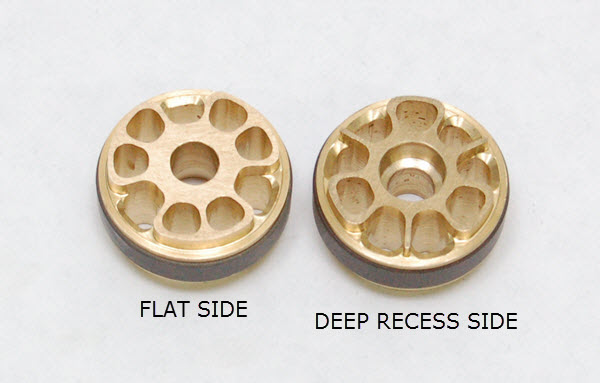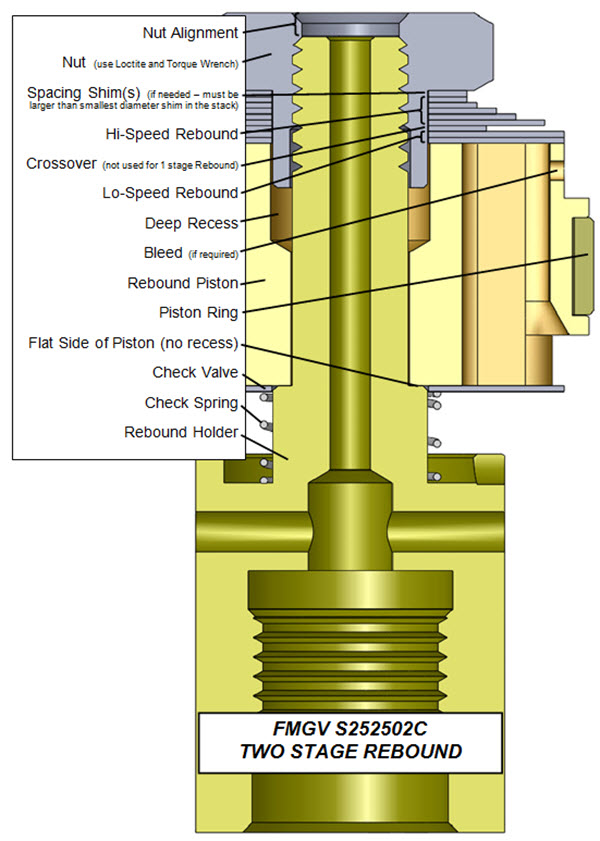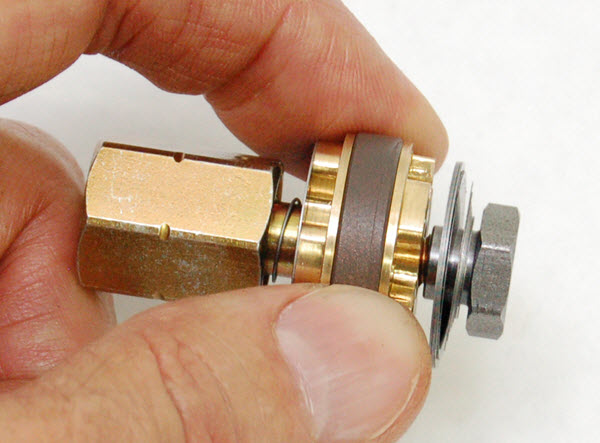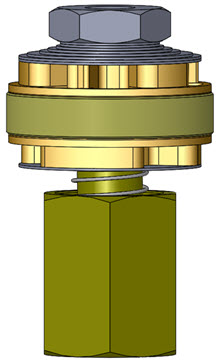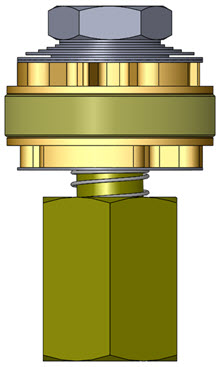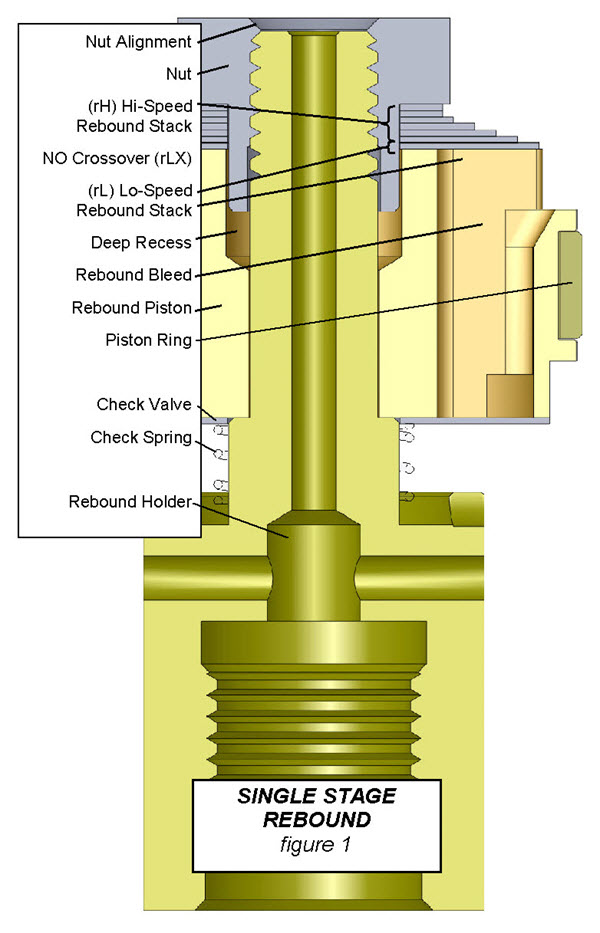FORK REBOUND
|
|||||||
|
|
Tools Required
- In-lb torque wrench that accurately measures 0 to 50 in-lbs (0.58 kgf-m) (SnapOn Digital Torque Wrench shown)
- Hi-Strength Loctite (included)
- Metric calipers and micrometer
|
||||||
|
|
VR1- Put the Check Spring and Check Plate on the Valving Shaft.
|
||||||
|
|
|||||||
|
|
VR3- REBOUND BLEED HOLE
If the DVS does not call for a Rebound Bleed Hole skip this step.
If your DVS Setup Sheet calls for a Rebound Bleed Hole make sure there is one pre-drilled in the piston. If one is called for, and there is no pre-drilled bleed hole, you will need to drill one.
Notice that the bleed hole is on the side of the piston with the Deep Recess and is drilled sideways. It connects the two sides of the piston and bypasses the valving stack. The exact location is not critical.
|
||||||
|
VALVING STACK TYPES - SINGLE OR TWO STAGE
VR4- You will either be building a Single Stage or a Two Stage Stack. The difference is the Crossover. The Crossover is a smaller diameter shim between the Lo-Speed and the Hi-Speed Stacks. Note: The DVS Custom Setup Sheet displays individual shims and does not label Hi-Speed, Crossover, and Lo-Speed. This is for your information only. Also you will not use all the shims provided in the Gold Valve Kit.
|
|||||||
|
|
VR5- Two Stage Example
(Single Stage is exactly the same except there is no Crossover) For Two Stage the total valving stack is made up of a:
Lo-Speed Stack
Crossover and a
Hi-Speed Stack
(this is only an example - not your setting)
The Total Valving Stack starting from the Gold Valve piston face:
(4) .15x24 - Lo-Speed Stack
(1) .10x16 - Crossover (notice the smaller diameter)
(1) .10x24 - Hi-Speed Stack
(1) .10x22
(1) .10x20
(1) .10x18
(1) .10x16
(1) .10x15
(1) .10x14
(1) .10x13
(1) .10x12
|
||||||
|
|
VR6- Put the valving on the Special Nut in the order listed starting with the smallest diameter shim of the Hi-Speed Stack.
|
||||||
|
|
VR7- Use Loctite in the Nut...
|
||||||
|
|
VR8- then install the Nut finger tight onto the Rebound Shaft while holding the Rebound Gold Valve back against the step on the Rebound Shaft. This keeps the Check Plate aligned during assembly.
Note - In case you were wondering, the nut is not finger-tight yet in this pic.
|
||||||
| VR10- Single Stage
|
VR9- Two Stage | ||||||
|
|
For both stack types.
Check and set the NUT ALIGNMENT
(this is determined by the Total Stack Height)
VR10- The Nut must stick up higher than the end of the shaft. It can be flush (even with the end of the shaft) or the Nut can stick up as much as 1mm (.040").
If the Nut is too low it can run out of thread on the shaft. If this is the case, add spacing shims just under the Nut. Make sure the spacing shims are larger diameter than the smallest shim in the stack. |
||||||
|
|
VR11- Make sure there is Loctite on the Nut and tighten it to spec with a torque wrench.
CAUTION! The threads can be damaged without extreme care. You must use Loctite. The 6mm bolt must be torqued with a torque wrench to 30 in-lbs (2.5 ft-lbs or 0.35 kgf-m), NO MORE! Do not take this step lightly. |
||||||
|
|
VR12- Inspect the Check Plate to make sure it is free and can move up and down against the Spring.
|
||||||
|
|
VR13- Visually check your work.
Hold the Compression Stack up to the light and look for proper assembly. If there are any problems, disassemble the stack and look for burrs to surface and/or dirt in the valving. Reassemble and check again.
Make sure the shims, on both sides, closest to the piston face completely cover the ports.
|
||||||
|
|
VR14- Make sure the shims that go next to the Gold Valve completely cover the ports on both sides of the piston! If the ports are not covered there will not be enough damping.
This could be caused by a number of reasons. Please call Tech Support if this occurs and you can't figure it out.
|
||||||
|
|
VR15- See the FMGV S252502C Rebuild Instructions and continue with installation of the Rebound Valve Assembly onto the Damping Rod and fork assembly.
|
||||||
| • Single Stage - made of: Lo-Speed Stack Hi-Speed StackThere is NO Crossover (it becomes one stack.) |
 |
 |
| • Two Stage - made of: Lo-Speed Stack Crossover Hi-Speed StackThe Crossover Gap is visible |
 |
 |




